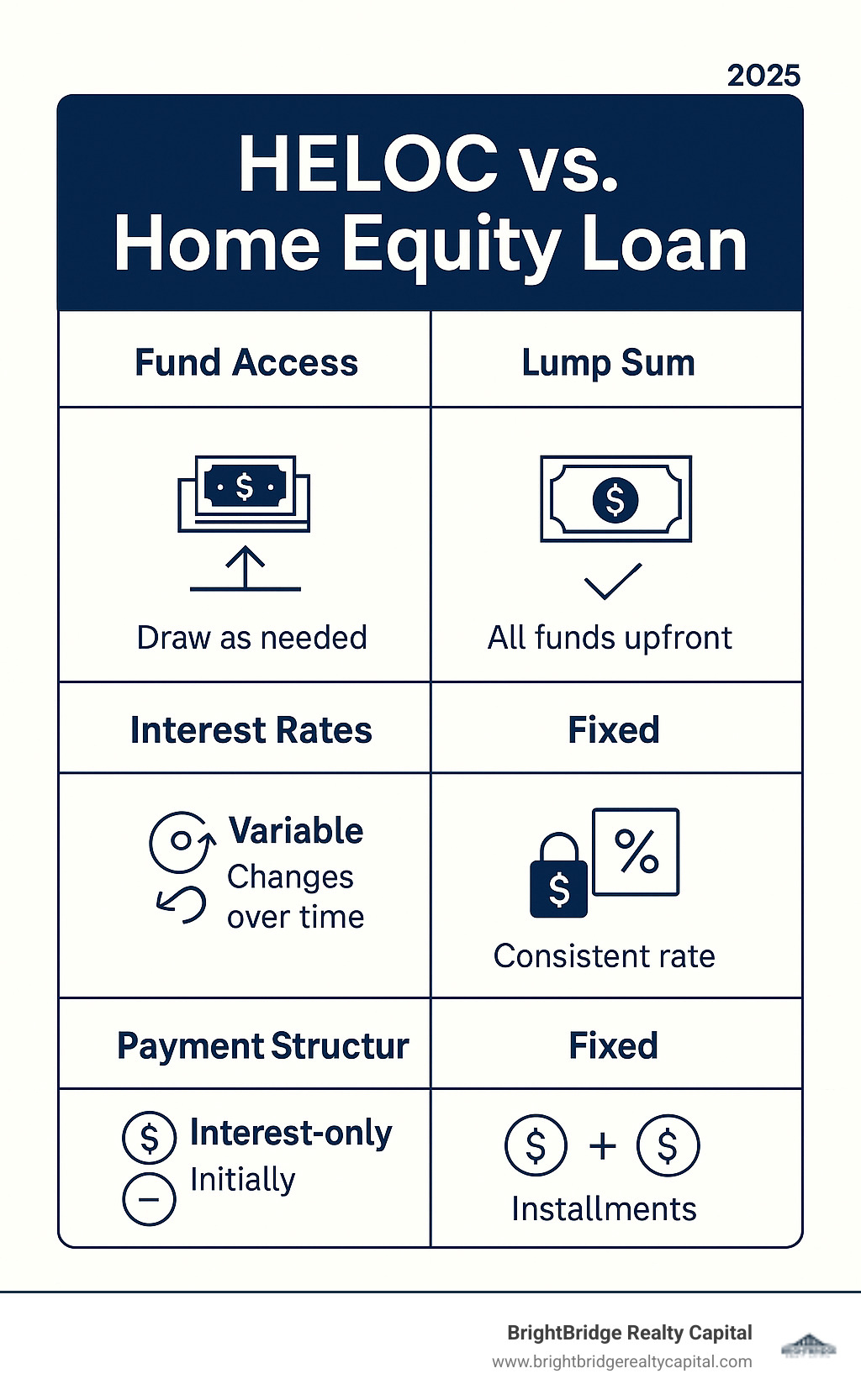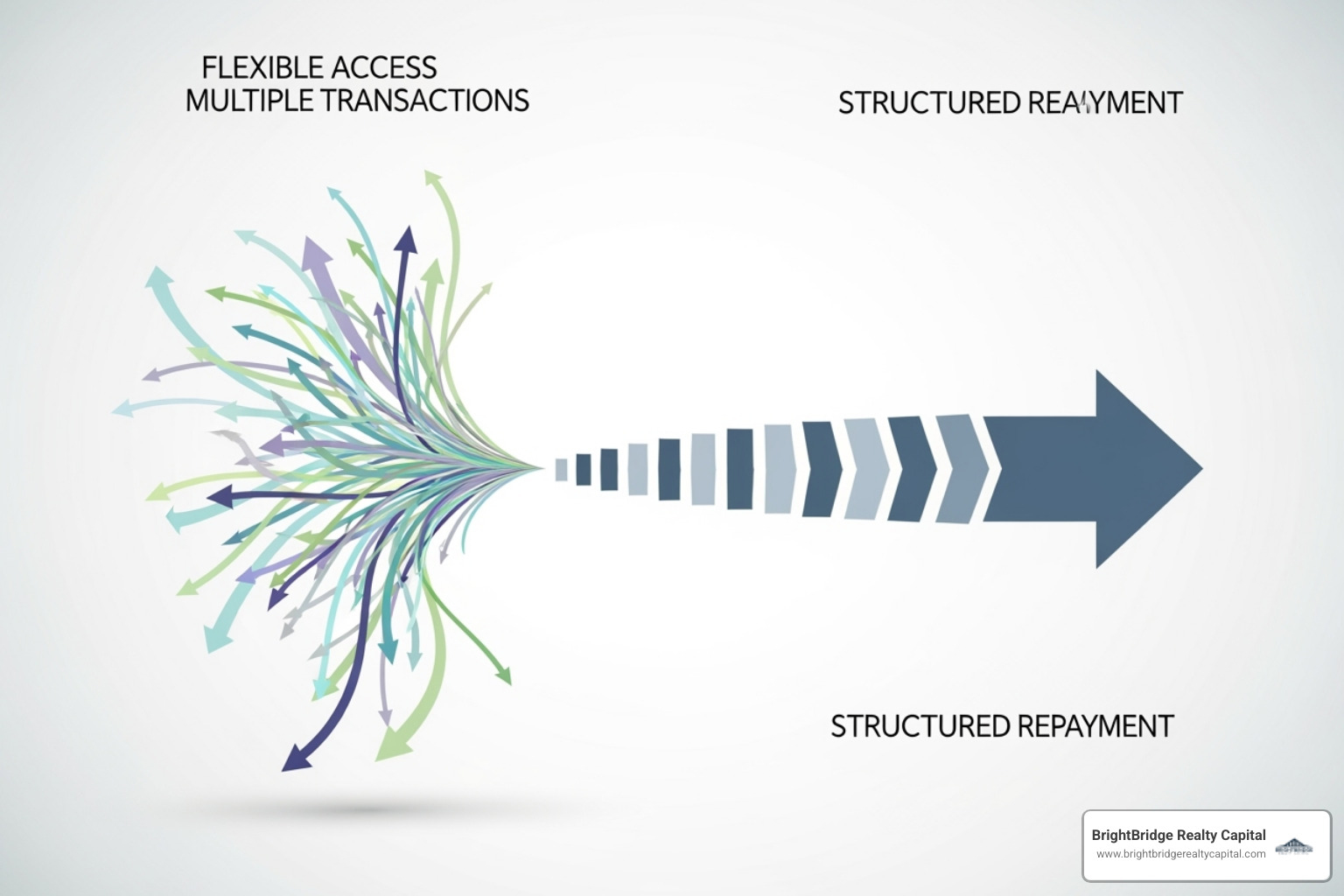Unlock Your Home's Potential: A Practical Guide to How HELOCs Operate

Why Understanding HELOC Mechanics Is Essential for Real Estate Investors
How does a home equity line of credit work? A HELOC is a revolving line of credit secured by your home's equity. It lets you borrow funds up to a set limit during a draw period (typically 5-10 years) and then repay the balance over a repayment period (usually 10-20 years).
Quick Answer for Real Estate Investors:
- Access Phase - Borrow against your home's equity as needed, up to 65-85% of your property value.
- Interest Structure - Pay interest only on what you use, typically at variable rates.
- Flexible Usage - Fund fix-and-flip projects, rental property improvements, or portfolio expansion.
- Repayment Terms - Make interest-only payments during the draw period, then principal and interest payments later.
Unlike a home equity loan's lump-sum payout, a HELOC works like a credit card backed by your property. You can draw funds, repay them, and borrow again, making it ideal for real estate investors who need flexible financing for ongoing projects. During the draw period, you often only pay interest on the borrowed amount. Once the repayment period starts, your payments will increase to cover both principal and interest.
I'm Daniel Lopez, a loan officer at BrightBridge Realty Capital. I've seen that investors who grasp these mechanics make smarter borrowing decisions and avoid common pitfalls that can derail profitable deals.

HELOC vs. Home Equity Loan: Understanding the Key Differences
When tapping into your home's equity, you'll choose between a HELOC and a home equity loan. Think of it as a flexible credit card (HELOC) versus a traditional installment loan. While both borrow against your property's value, they function very differently.

The main difference is how you access the money. A home equity loan provides a single lump sum upfront with a fixed interest rate and predictable monthly payments. A HELOC offers a revolving line of credit you can draw from as needed, usually with a variable interest rate. Understanding how does a home equity line of credit work in comparison is key to choosing the right product for your needs.
Most lenders allow you to borrow up to 80-85% of your home's equity with either option, though specific loan-to-value (LTV) limits can vary.
For a detailed breakdown, see our guide: HELOC vs. Home Equity Loan.

What is a Home Equity Line of Credit (HELOC)?
A HELOC is a revolving credit line that uses your home as collateral, similar to a credit card but with better interest rates. You're approved for a maximum limit based on your equity, but you only borrow as needed. If you have a $100,000 limit and use $20,000, you only pay interest on that $20,000. As you repay the balance, that credit becomes available to use again. This flexibility makes HELOCs ideal for ongoing projects or uncertain expenses. Learn more in our guide: What is a HELOC?.
What is a Home Equity Loan?
A home equity loan, or second mortgage, provides a one-time payment of a fixed amount. Once you receive the funds, you begin making predictable monthly payments of principal and interest for a set term (often 10-30 years) at a fixed interest rate. This structured repayment is perfect when you know the exact cost of a large, one-time expense, like a major home addition. Once the loan is paid off, the account is closed.
How Does a Home Equity Line of Credit Work? The Mechanics Explained
A HELOC operates in two distinct phases: a draw period for accessing funds and a repayment period for paying them back. Understanding these stages is absolutely critical to managing your finances effectively and avoiding common pitfalls.

Most HELOCs have variable interest rates tied to a benchmark index, most commonly the U.S. Prime Rate, plus a margin set by the lender. The prime rate is the interest rate that commercial banks charge their most creditworthy customers and it generally moves in lockstep with the Federal Reserve's federal funds rate. The margin is an additional percentage added by the lender, which is determined by your credit score, loan-to-value ratio, and other risk factors. For example, if the prime rate is 7% and your margin is 1.5%, your fully indexed rate is 8.5%. As the prime rate changes, your interest rate and monthly payment will adjust accordingly, often on a monthly or quarterly basis. Some lenders may offer a low introductory "teaser" rate for the first few months before the rate adjusts to the fully indexed variable rate.
The Draw Period: Accessing Your Funds
The draw period is your window to borrow, typically lasting 5 to 10 years. During this time, you can access funds up to your credit limit as needed, using special checks, a dedicated debit or credit card, or by making online transfers to your checking account. During this phase, many HELOCs only require interest-only payments on your outstanding balance. This keeps initial payments low and maximizes cash flow. For example, if you draw $30,000 on your HELOC at an 8% interest rate, your minimum monthly payment would be just the interest: ($30,000 * 0.08) / 12 = $200. Because it's a revolving credit line, any amount you repay (beyond the interest) becomes available to borrow again, offering continuous and flexible access to capital.
The Repayment Period: Paying Back the Balance
Once the draw period ends, the repayment period begins, usually lasting 10 to 20 years. At this point, your credit line is closed, and you can no longer borrow funds. Your monthly payments will now include both principal and interest, calculated to pay off the remaining balance over the loan's term (a process called amortization). This transition can lead to a significant payment increase, a phenomenon known as "end of draw shock." Using our previous example, if you still have a $30,000 balance at the end of the draw period and your rate is still 8%, your new fully amortized payment over a 15-year repayment term would be approximately $287 per month—a substantial jump from the $200 interest-only payment. To mitigate this shock, it is highly advisable to make voluntary principal payments during the draw period, rather than just the interest-only minimum.
How is the Borrowing Limit for a HELOC Determined?
Your borrowing limit is determined by a formula based on your home's equity and your financial profile. First, a professional home appraisal is conducted to establish your property's current market value. Then, your equity is calculated by subtracting your outstanding mortgage balance from the appraised value.
Most lenders use a metric called the Combined Loan-to-Value (CLTV) ratio, often capping it at 80% or 85%. This means your total home-secured debt (your primary mortgage + the new HELOC) cannot exceed that percentage of your home's value. For example, if your home is appraised at $500,000 and you owe $250,000 on your mortgage, you have $250,000 in equity. If the lender's maximum CLTV is 85%, the total allowable debt is $425,000 ($500,000 * 0.85). To find your maximum HELOC limit, you subtract your current mortgage balance from this amount: $425,000 - $250,000 = $175,000. Therefore, your maximum HELOC credit line would be $175,000. Lenders also perform a deep assessment of your creditworthiness, including your credit score and payment history, and your debt-to-income ratio to ensure you have the capacity to afford the new payments.
Qualifying for a HELOC: What Lenders Look For
Getting approved for a HELOC involves a financial review similar to a mortgage application. Lenders assess your equity, credit, income, and overall debt to ensure you're a reliable borrower. The process requires financial documentation, proof of income, and property details. For a full walkthrough, see our guide on How to Apply for a HELOC.
Home Equity Requirements
Your home equity is the collateral for the loan. Most lenders require you to retain at least 15-20% equity in your home after the HELOC is issued. Your available equity is calculated by subtracting your mortgage balance from your home's current appraised value. For example, a home appraised at $400,000 with a $160,000 mortgage has $240,000 in equity, or a 60% equity stake.
Credit Score and Debt-to-Income (DTI) Ratio
Your financial health is measured by your credit score and DTI ratio.
- Credit Score: A minimum score of 620 is often required, but scores of 750 or higher typically receive the best rates and terms. Lenders will perform a full credit history review.
- Debt-to-Income (DTI) Ratio: This compares your total monthly debt payments to your gross monthly income. An ideal DTI ratio is below 43%, as it shows you can manage additional debt. The Consumer Financial Protection Bureau offers a helpful explanation: What is a Debt-to-Income Ratio?.
Associated Interest Rates and Fees
Understanding the costs is crucial. Most HELOCs have variable rates, composed of the prime rate plus a lender's margin. As the prime rate fluctuates, so will your payment. Some lenders offer fixed-rate options to lock in a rate on a portion of your balance, providing payment predictability. See current trends on our HELOC Interest Rates page.
Be aware of potential fees, which can include:
- Origination fees for processing the loan.
- Appraisal costs to determine your home's value.
- Annual fees to maintain the credit line.
- Closing costs, similar to a mortgage.
Always ask for a complete list of fees upfront.
The Pros, Cons, and Risks of Tapping Into Your Home's Equity
A HELOC offers significant financial flexibility but also comes with serious risks. It's a powerful tool that requires financial discipline, as your home serves as collateral.

The biggest risk is foreclosure if you fail to make payments. The temptation to overspend is also a concern, as you have easy access to a large credit line. Understanding how does a home equity line of credit work means weighing both the opportunities and the potential consequences.
The Advantages of a HELOC
HELOCs are popular for several key reasons:
- Financial Flexibility: Unlike a lump-sum loan, you borrow only what you need, when you need it.
- Lower Interest Rates: Rates are typically lower than those for credit cards and personal loans because the loan is secured by your home.
- Interest-Only Payments: The draw period often allows for interest-only payments, which keeps monthly costs low and improves cash flow.
- Access to Large Sums: Depending on your equity, you can access a substantial amount of capital.
These features make a HELOC an excellent choice for funding ongoing projects, creating an emergency fund, consolidating high-interest debt, or financing major life events. Explore more in our guide on the Benefits of a HELOC.
The Disadvantages and Risks Involved
Before applying, carefully consider these significant risks:
- Risk of Foreclosure: This is the most serious risk. Since your home is the collateral, defaulting on payments could lead to losing it.
- Variable Rate Uncertainty: Most HELOC rates are variable. If market rates rise, your payments can increase unexpectedly, straining your budget.
- Potential for Negative Equity: If your home's value drops, you could owe more than it's worth (being "underwater"). This can make it difficult to sell or refinance, and your lender may even freeze your credit line.
- Temptation to Over-borrow: The ease of access to funds can lead to unnecessary spending and unmanageable debt.
- Balloon Payments: Some HELOCs require the entire balance to be paid in a lump sum at the end of the draw period. Be sure to understand your loan's terms to avoid this surprise.
Smart Ways to Use a HELOC (And the Tax Rules to Know)
Strategically using a HELOC can help you achieve your financial goals. The best uses are those that increase your wealth or improve your financial standing, such as investing in assets that appreciate in value.

How does a home equity line of credit work for home renovations or debt consolidation?
- Home Improvement Projects: Using a HELOC to renovate your home can increase its market value, providing a direct return on your investment.
- Debt Consolidation: Moving high-interest debt from credit cards (e.g., 18-24% APR) to a lower-interest HELOC (e.g., 7-9% APR) can significantly reduce your monthly payments and total interest paid.
- Education Expenses: HELOC rates are often more favorable than student loan rates, making them a cost-effective way to fund education.
- Emergency Fund: A HELOC can serve as a ready source of cash for unexpected events like major home repairs or medical bills, without you having to pay interest until you use it.
- Investment Opportunities: For real estate investors, a HELOC provides quick access to capital for down payments or property acquisitions, allowing you to act fast on promising deals.
Are there any tax advantages to using a HELOC?
Yes, but the rules have changed. Following the Tax Cuts and Jobs Act, the interest on HELOC debt is only tax-deductible if the funds are used to "buy, build, or substantially improve" the home that secures the loan.
This means if you use your HELOC for a kitchen remodel or to add a new room, the interest may be deductible. However, if you use the funds to pay off credit cards or buy a car, the interest is not deductible. The improvements must add value or prolong the home's life; routine maintenance typically doesn't qualify.
Always consult with a qualified tax professional about your specific situation, as tax laws can be complex and are subject to change.
Frequently Asked Questions about HELOCs
Here are answers to some of the most common questions we receive at BrightBridge Realty Capital about how does a home equity line of credit work.
Can I pay off a HELOC early?
Yes, you can typically pay off your HELOC balance at any time without penalty. However, some lenders charge a prepayment penalty if you close the account within the first few years of opening it. This fee helps them recover their initial setup costs. Always check your loan agreement for specific terms. If you sell your home, you will be required to pay off the HELOC in full at closing.
What happens if my home's value drops?
If your home's value falls significantly, you could end up in negative equity, meaning you owe more on your home (mortgage plus HELOC) than it's worth. While this isn't a problem if you can continue making payments, it can create an immediate issue: your lender might freeze or reduce your credit line. Most HELOC agreements allow this to protect the lender if the collateral's value decreases, which is why it's wise not to rely on a HELOC as your only source of emergency funds.
How long does the application and closing process take?
The timeline from application to funding typically takes two to six weeks. The process includes several steps: submitting and reviewing your financial documents, scheduling and completing a home appraisal, and undergoing the lender's underwriting review. Once approved, you'll go through a closing process similar to a mortgage. While some lenders offer faster turnarounds, it's best to plan for at least a month to avoid delays.
Conclusion: Is a HELOC the Right Tool for You?
By now, you know how does a home equity line of credit work: it's a flexible financial tool that lets you borrow against your home's equity as needed. It offers revolving credit and lower interest rates than unsecured loans, making it ideal for ongoing projects or consolidating debt.
However, it comes with risks, including variable interest rates and the temptation to overspend. Most importantly, your home is the collateral, and failure to pay could lead to foreclosure. A HELOC is a game-changer when used with a disciplined financial plan.
For real estate investors, a HELOC is particularly valuable. It provides quick capital for fix-and-flips, property improvements, or portfolio expansion. The ability to draw, repay, and redraw funds aligns perfectly with the fluid nature of real estate investing.
While HELOCs are excellent, they aren't always the fastest option for time-sensitive deals. For investors who need fast, reliable capital to seize opportunities, specialized financing from a direct lender like BrightBridge Realty Capital offers a competitive edge. We understand that in real estate, timing is everything.


